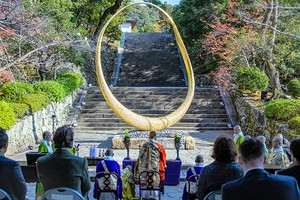By KENTA NAKAMURA/ Staff Writer
April 8, 2024 at 17:58 JST
Japan’s first “ride-sharing” service started in Tokyo on April 8, allowing ordinary people to use their own cars to transport customers during times of taxi shortages.
Unlike popular services abroad, such as Uber and Lyft, drivers under the Japanese system are hired by taxi companies, which provide training in transporting people and work management.
The newly introduced system is a complementary “cashless” service that operates only in certain areas and at certain times when there is a need for extra taxis.
The Tokyo Hire-Taxi Association held a ceremony to start the service on the morning of April 8.
Transport minister Tetsuo Saito experienced a test-ride and said he felt the vehicle was safe and secure.
“Since passengers cannot confirm the safety of the vehicles, I hope (the companies) make efforts to manage safety on par with taxis,” he said.
The ministry on April 1 lifted the ban on ride-sharing for commercial purposes in certain areas with limited time slots.
The areas are: Tokyo’s 23 wards and the cities of Musashino and Mitaka; four cities in the Keihin area of Kanagawa Prefecture, including Yokohama and Kawasaki; Nagoya and 11 other cities and three counties in Aichi Prefecture; and Kyoto city and seven other cities and four counties in Kyoto Prefecture.
All of these areas are expected to begin offering ride-share services by the end of April.
Later, the ride-sharing ban is expected to be lifted in eight cities: Sapporo; Sendai; Saitama; Chiba; Osaka; Kobe; Hiroshima; and Fukuoka.
Only taxi companies can enter the ride-share market. And in principle, ride-sharing drivers in Japan must have an employment relationship with a taxi company.
Individual drivers cannot start operating simply by registering with a cab dispatch app, as is the case in the United States.
The central government plans to hold discussions in June on whether to allow non-taxi companies to enter the ride-sharing market.
HOW RIDE-SHARING SERVICE WORKS
Customers cannot hail a ride-sharing vehicle on the street like they do with normal taxis.
Instead, they summon a ride-sharing vehicle using a taxi dispatch app, such as “Go” and “S.Ride,” during hours specified by the transport ministry.
The passengers select either the pick-up or drop-off locations within the designated area, and the app shows the fare up-front.
The vehicles do not have an “andon,” a sign on the roof of taxis. Nor do they have meters showing the fare.
In principle, the fares are about the same amounts charged by cabs hailed via the app.
When the car arrives at the destination, passengers use a cashless payment method to cover the fare.
Unlike for taxi rides, the ride-sharing fare remains the same even if the drive takes longer or shorter than expected.
If passengers change the pick-up or drop-off location, or ask the driver to take expressways, the original fare will be adjusted accordingly.
For Go app users, customers cannot specifically request a ride-share car. Either a taxi or a ride-share vehicle will arrive at the pick-up location.
Customers, however, can still request the dispatch of a taxi.
Go Inc., the company that operates the taxi app, has not disclosed the number of ride-share drivers it has partnered with.
But a company representative said it represents a very small percentage of its total fleet, which includes taxis, and that “taxis will most likely be dispatched” through the app.
Uber Japan, the Japanese arm of Uber Technologies Inc., plans to sign partnerships with about 10 taxi companies to start a ride-sharing service with several dozen cars.
The company’s Uber Eats service has already spread around Japan, and it has asked Uber Eats delivery workers to become ride-share drivers.
About 1,000 Uber Eats delivery workers have expressed interest, the company said.
“We would like to try it out first and see what feedback we get from drivers and (taxi) companies before moving forward,” Shiro Yamanaka, who heads Uber Japan, said.
Currently, taxi companies that have an employment relationship with drivers manage and operate ride-sharing services.
Royal Limousine Inc., a taxi dispatcher based in Tokyo’s Koto Ward, is one of the companies that entered the ride-sharing service market.
To ensure safety, the company’s staff members check the health and other conditions of ride-share drivers before they drive off. Drivers are also informed of weather and road conditions.
An alcohol detector inside the car checks if the driver has consumed alcohol, and the data from the test is sent to the company’s office.
The transport ministry determines the number of ride-share vehicles in operation.
In March, the ministry announced the number of additional taxis needed in each business district based on data from various taxi-dispatch apps.
The ministry will allocate a certain number of ride-share vehicles for each taxi company entering the market. The numbers will be capped to prevent them from exceeding the shortages.
The ministry says the greatest shortage is in Tokyo on Saturdays from midnight to 4 a.m., when 2,540 extra vehicles are needed.
To address the situation, the ministry will first distribute half of the 2,540 shortfall to taxi companies that wish to enter the market. The remaining vehicles will be held back for future entry.




















A peek through the music industry’s curtain at the producers who harnessed social media to help their idols go global.
A series based on diplomatic documents declassified by Japan’s Foreign Ministry
Here is a collection of first-hand accounts by “hibakusha” atomic bomb survivors.
Cooking experts, chefs and others involved in the field of food introduce their special recipes intertwined with their paths in life.
A series about Japanese-Americans and their memories of World War II